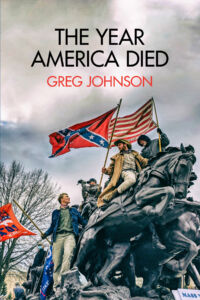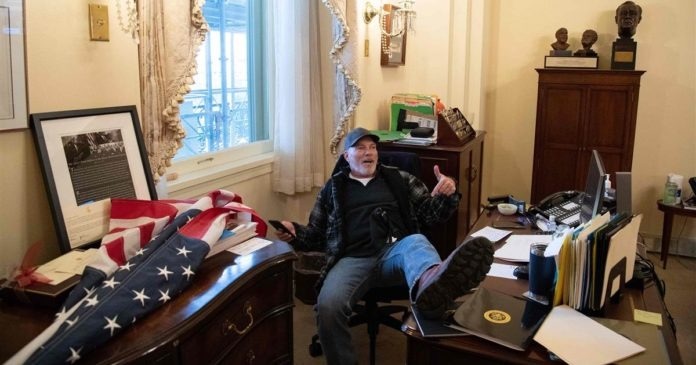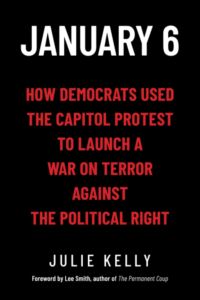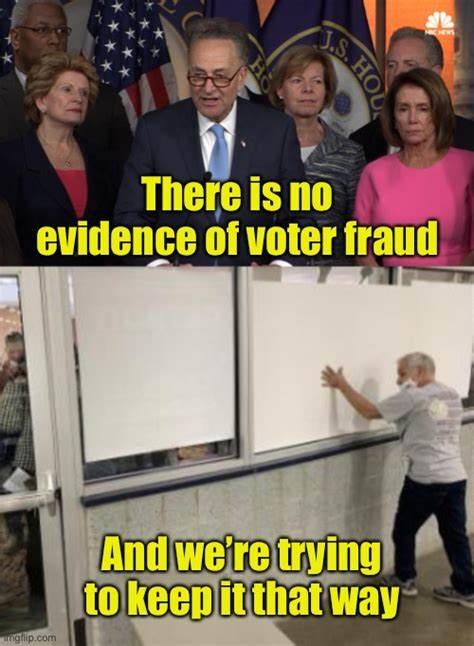January 6 & Its Meaning
Posted By Morris van de Camp On In North American New Right | Comments DisabledJulie Kelly
January 6: How Democrats Used the Capital Protest to Launch a War on Terror Against the Political Right
New York: Post Hill Press, 2022
The stampede of Trump supporters in and around the United States Capitol on January 6, 2021 was a big nothing, and a revolutionary event at the same time. The ultimate meaning and endpoint of January 6 has yet to be fully understood, but a decent overall account of the event has emerged from Julie Kelly [2], a reporter for American Greatness [3].
 [4]
[4]Election officials in Africanized Detroit: Sub-Saharans have been used as tools in voter fraud schemes since the end of the Civil War. In the early 1900s, sub-Saharans in the Republican Party, called Black and Tans, could make or break a candidate in a close primary, convention, or election. At that time they were throwing their weight behind one white over another at a time of white demographic stability. Today, they are aiding the Great Replacement. Whites have their future in the hands of the same people who delivered the unjust O. J. Simpson verdict.
The Road to January 6
The crisis of January 6, 2021 started as early as 2016, when the mainstream media insisted that “the Russians” had “hacked” the election. For nearly two years, the press, the FBI, and members of Congress looked under every rock to prove that the Russians had indeed caused Trump to win. Then, strangely, although the election of 2020 was decided in a highly [5] unusual way, [6] that same media, FBI, and members of Congress insisted that any claims of impropriety were “baseless.”
On February 27, 1968, Walter Cronkite’s editorial [8] about the situation in Vietnam changed the minds of millions of Americans. But in 2020, a large swath of the white American public didn’t believe a word of anything the media said. Additionally, the press’ Left-leaning bias was universally known, and it is easy for whites to recognize when the media [9] is lying [10]. The election reporting in 2020 was an obvious case of dishonesty. Outrage followed immediately.
Kelly writes,
Donald Trump himself clearly bears some responsibility for fueling unsatisfied outrage about the 2020 election. He warned for months that the election would be stolen yet his legal teams seemed unprepared to handle the onslaught of election irregularities and outright unlawfulness . . . (p. 69)
This was one of Donald Trump’s weaknesses as President. Although he could point out enormous problems and win the loyal following of millions of white American yeomen, he was unable to recruit and employ a loyal and capable staff. His lawyers promised to “release the Kraken [11],” but failed to prove any of their claims even to friendly interviewers such as Tucker Carlson. Additionally, the GOP establishment at the state and local levels was either dishonest, such as Georgia’s [12] Brad [13] Raffensperger [14], or completely impotent in the face of preventing the steal.
For its part, the legal system itself also has difficulty dealing fairly with election fraud. Lawsuits filed in relation to election fraud were dismissed either because they were “premature” prior to the election, or because they were “too late” afterwards. Trump lost on technicalities.
Another problem with Trumpism is that although it was a rational response to problems pertaining to trade, military policy, and the Great Replacement, it emerged too early. There were too few people in elite positions who understood or believed in Trump’s message. A hostile elite has ample opportunity to sabotage any president’s policy. The Trump administration can be likened to Abraham Lincoln becoming President in 1790 — without a Republican Party, the Union Army, or seven decades of abolitionist/Free Soil metapolitics.
The January 6 Timeline
There was no reason to suppose the Trump rally on January 6 would be unusual. There had been a Trump rally in DC on November 14, 2020 where things went smoothly barring the hyena-like BLM/antifa attacks on lone Trump supporters, the elderly, and so on. Trump’s supporters arrived peacefully in large numbers on the evening of January 5. Trump made appeals for calm. The sub-Saharan mayor of Washington, DC also appealed for calm, but strangely, refused to call in more troops or police to help keep the peace.
 [15]
[15]You can buy Greg Johnson’s The Year America Died here. [16]
The President’s first tweet to his supporters on January 6 came at just before 1 AM. At 3 AM, Trump supporters started to gather near the Capitol. At 9 AM the official program started, with various notables discussing the fraudulent election. Trump began his speech at noon. Meanwhile, in the Capitol building, both houses of Congress met to certify the election results. A “pipe bomb” was discovered and given over to the FBI for analysis at this time.
At 12:53 PM, a group of Proud Boys, led by FBI informant Joe Biggs [17], gathered near Peace Circle at the pedestrian entrance. Biggs led the crowd in chanting, “We love Trump!” Another FBI informant and agent provocateur, Ray Epps [18], had encouraged people to enter the Capitol the previous night. He began pushing against the fencing, and others joined him. At 1 PM, the fencing was breached, and the crowd began chanting “USA! USA!”
Congress was still unaware of the gathering threat at this time. Vice President Pence was arguing that although there are “numerous instances of officials setting aside state election law,” he did not believe that he had the authority to address unlawful conduct in the election. (This was a highly dubious interpretation of the matter in that he swore an oath to the Constitution.)
At 1:15 PM, Trump finished his speech. There was a sharp “escalation of anger and violence” (p. 41) when the DC Metro Police started firing sting balls into the crowd. The fact that the DC police behaved more aggressively deserves further remarks. The Capitol Police were mostly polite, but the DC Metro cops were under the authority of a sub-Saharan mayor who had tolerated a BLM-inspired riot that had caused Trump to take shelter in the White House bunker the previous spring. There were two different organizational cultures at work: one professional and accustomed to dealing with protests, the other Africanized. After a year of supporting the police throughout the BLM/antifa riots, Trump supporters were shocked and enraged to find themselves under police attack.
The protestors started to move in, breaching the fencing and unfurling flags. The police ordered the evacuation of several buildings due to the “pipe bombs.” At 2 PM the protestors began to enter the Capitol itself. At 2:05, Kevin Greeson of Alabama died of a heart attack after being hit in the eye by a fragment of an explosive device that had been thrown into the crowd by police. By 2:13, members of Congress received word about the scale of the breach and began to don protective masks and take shelter. At 2:25, Capitol police officers instructed the QAnon Shaman, Jacob Chansley, to behave, but they didn’t stop him and others with him from entering the Capitol.
Meanwhile, Glenn Croy of Colorado, a Trump supporter, watched as the DC Metro police brutally assaulted a protester for “no apparent reason.” Protesters inside the Capitol were staying within the rope lines and taking selfies. At 2:43, a sub-Saharan police officer named Michael Byrd shot Ashli Babbitt in the neck, killing her. At 2:50, the QAnon Shaman was in the Senate chamber and led the rest of the protestors in prayer. The police calmly asked the protestors to leave, and none of them were violent.
Over the next hour, the protest became increasingly violent. Trump appealed for calm via Twitter, but it was too late. The entrance tunnel to the Capitol became a battle scene. The police used tear gas and pepper spray in the cramped area. Rosanne Boyland became trapped in the melee and was trampled to death as officers pushed against the crowd. She was pronounced dead at 6:09 PM. Benjamin Phillips of Pennsylvania, also a Trump supporter, died of a stroke, but the specifics of his death remain unclear. By 8 PM the riot was over, and Congress moved to certify the election.
The Elite’s Insurrection Narrative
All members of Congress closed ranks in the wake of the riot. Those who sought to protest the election switched positions immediately. Big Tech threw Trump off Twitter, and other establishment voices condemned the protest and Trump himself.
Over the following weeks, the FBI swooped in to make arrests. Protestors were turned in by family members and friends or were identified via crowd sleuthing in photos that had gone viral. Retired US Army Lieutenant General Russel Honoré was tasked by Nancy Pelosi with getting to the bottom of the security failures.
 [20]
[20]Richard Barnett of Arkansas was arrested after being filmed in Nancy Pelosi’s office, yet this was not the first time it had been occupied.
The system that had made Russel Honoré a general is the reason why the United States military cannot win wars. His initial — but now deleted — tweet about the situation is a reflection on his intellectual incompetence and lack of judgment:
I generally know how this shit is supposed to happen today secure the Capital (sic). This was a shit show today the @CapitalpoliceLS were on their Ass.
He posted about Senator Josh Hawley thusly:
This little piece of shit with his @Yale law degree should be run out of DC and Disbarred ASAP. (p. 93)
Notice the partisanship, poor grammar, and vulgarity sent out at a time when the entire world was watching his every move. Military men are limited, and those who gain high office in that institution are the ones who best paper over the ferocious racial troubles plaguing the institution. One can read Honoré’s report here [21]. It is filled with buzzwords, but fails to note that the anti-Trump political establishment had been encouraging violence throughout 2020 after spending the previous four years insisting that the 2016 election had been “hacked” by “the Russians,” and had pushed lies and misinformation via the mainstream media.
On Inauguration Day, Washington was a military occupation zone. Biden’s inaugural address was a less than inspiring speech delivered to an empty plaza. It is remarkable that none of his supporters turned out for him — another indicator that his election victory was a fraud. It was also a clear sign of incredible political instability at the heart of the Empire of Nothing.
Trump was impeached for a second time, but found not guilty by the Senate.
Narrative Collapse
The January 6 event was not unprecedented. Nancy Pelosi’s office had been occupied in October 2019 by “climate change” activists; Pelosi herself had tweeted her support for them at the time. The hearings for Brett Kavanaugh’s confirmation had likewise been disrupted by Democrats and feminists. Those arrested were quickly released. In 2011, Democrats in Wisconsin occupied the State Capitol for 17 days. There were some arrests, but no calls for revenge or declarations that an insurrection had taken place.
The mainstream media moved as fast as possible to destroy Ashli Babbitt’s reputation. The fact that she had only made the rank of Senior Airman indicated her military career had been less than stellar, they claimed. (Every military career is swiftboatable [22].) Babbitt’s arguments with neighbors were likewise amplified and any flaws in her personal life they could find were highlighted. It is important to note the contrast: When the life stories of Democratic and Leftist heroes such as the sub-Saharans Mike Brown or George Floyd are examined, we find dangerous men with long criminal histories. Babbitt was a veteran, business owner, and solid citizen. After she failed to return from DC, her dog died of grief.
In the short term, the January 6 event was a disaster for Trump and his supporters. Those arrested have been subjected to detention (in some cases solitary confinement), loss of employment, and there are credible accusations of torture. Many of the judges and prison guards in DC are sub-Saharans who are eager to harm white Americans. The Biden regime now has more political prisoners than do the governments of Syria and Myanmar.
But in the long term, the insurrection narrative has collapsed. The unfortunate policeman who died that day was a Trump supporter, and he died of natural causes unrelated to the riot. None of the protesters brought firearms, and prosecutors have had a very hard time discovering and proving more than trespassing in most cases.
Kelly argues that the idea of an insurrection ironically originated with Trump himself. After the BLM/antifa attack on the White House, he proposed invoking the Insurrection Act. The military treacherously pushed back against the idea, and cities like Portland burned as a result of their weakness.
Meaning
The January 6 event still has considerable meaning despite the collapse of the mainstream narrative surrounding it. The parallels to Caesar crossing the Rubicon are obvious. In the future, it is possible that a different President might send dual US-Israeli citizens who are highly experienced in cruelty in Occupied Palestine against Congress with the collusion of the media and establishment.
Hypotheticals aside, this event brought to a head the racial problems between American whites and sub-Saharans. The election was stolen in places where there were African election officials and large sub-Saharan populations. Babbitt’s killer was a sub-Saharan police officer who was protected by the media and Capitol police. Had the races been reversed, it is certain that he would be in jail or dead by now.
The January 6 Commission is ironically led by Bennie Thompson (D-MS), a sub-Saharan who advocated for a radical group called the Republic of New Africa in the 1970s, and he often slams law enforcement. Indeed, the Democratic Party elites had been pushing for protests and insurrection throughout 2020. It seems they don’t like it when rioters fight against them, however. The hypocrisy is obvious.
Essentially, January 6 highlighted the problem of sub-Saharan overrepresentation in the American political scene as well as the crisis of two clashing constitutions, the first being the US Constitution and the second being the 1964 Civil Rights Act. It also highlighted corruption and fraud in sub-Saharan-controlled political districts.
The political establishment moved to call the insurrectionists terrorists, but that charge has failed to stick. In general, the outrage over January 6 is confined to the media and Democratic Party, but it has diminished among the broader public. America has now entered a period of sustained crises that appear to have overwhelmed Biden and his regime. It is likely that Biden’s presidency was fatally wounded on election night — but that remains to be seen.
In the meantime, January 6 has caused considerable soul-searching among decent white liberals. Seth David Radwell argues for border security and election integrity in his book American Schism [23]. Barbara F. Walter likewise argues in her book on civil wars [24] that immigration should be cut back, and she recognizes that American whites are organizing as a group. The fact that the 1964 Civil Rights Act has been polarizing is now out in the open.
Julie Kelly goes to great lengths to insist that January 6 was not a “white supremacist” event. To a degree she is correct, but it was implicitly white since it came at a time of rising white racial consciousness. It might be that the January 6 protest was the start of a white political resurgence. Only time will tell.
* * *
Counter-Currents has extended special privileges to those who donate $120 or more per year.
- First, donor comments will appear immediately instead of waiting in a moderation queue. (People who abuse this privilege will lose it.)
- Second, donors will have immediate access to all Counter-Currents posts. Non-donors will find that one post a day, five posts a week will be behind a “paywall” and will be available to the general public after 30 days.
To get full access to all content behind the paywall, sign up here:
Paywall Gift Subscriptions
 [25]If you are already behind the paywall and want to share the benefits, Counter-Currents also offers paywall gift subscriptions. We need just five things from you:
[25]If you are already behind the paywall and want to share the benefits, Counter-Currents also offers paywall gift subscriptions. We need just five things from you:
- your payment
- the recipient’s name
- the recipient’s email address
- your name
- your email address
To register, just fill out this form and we will walk you through the payment and registration process. There are a number of different payment options.


